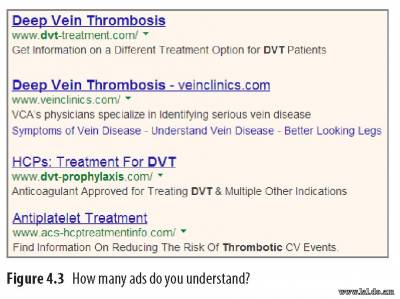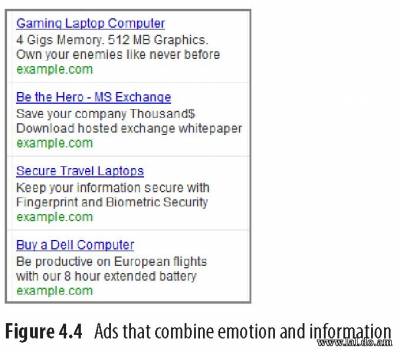Writing Effective Ads
Once your granular ad group organization is completed, it is time to think about the content of the ad copy. There are many ways of writing ad copy, some of which we will revisit in Chapter 15, “Implementing Testing Techniques That Will Increase Profits,” when we discuss ways of testing different ad copy messages to see which are more effective.
Ad copy must promote your goals for success. Before you begin advertising, it is important to determine the goals for your campaigns (which will be discussed in depth in Chapter 13, “Devising Profitable Bid Strategies”). Once you have established the goals, your ads should reflect those goals. Your ad should display your products’ features and benefits. This is so important that an upcoming section (“Distinguishing Features and Benefits”) focuses on this aspect of your ad. You want to make sure that the consumer identifies with your ad copy. Marketing is about identifying and connecting with consumers. Using your consumers’ language is important. If you use terms that your consumers do not understand or terms they do not often see, it can cause them to not identify with your ad copy and click on a competitor’s ad instead of yours (Figure 4.3).
Calls to Action Direct a consumer to take action. What do you want someone to do once they arrive at your site? When you tell someone what to do within the ad copy, it is going to predispose them to look for that action on the landing page. Some generic examples of calls to action are these:
Those who do not wish to take such action may not even click on your ad. If you are looking to increase CTR and views to a new product page (regardless of who buys the product), you may not want to add a purchasing or prequalifying call to action within the ad copy because it could lower CTR. This will be discussed in more depth in Chapter 6, “Learning Advanced Optimization Techniques,” when we examine optimizing your account for conversions. Often in search advertising, a straightforward marketing message connects cerebrally with visitors. By using logic and informational ad copy, you are trusting that the consumers can make decisions if they are presented with all the facts. This is very useful in ad copy writing—the purpose is to answer a searcher’s question, and an answer is made up of facts. This is also useful when you are trying to reach consumers who do intensive research before making a decision, which is common in B2B and technical fields. However, you will see higher CTRs and conversion rates if you also connect emotionally with a visitor. Touching the Emotional Core It is possible to connect both informationally and emotionally with a searcher. There are some common assumptions about what any person wants and what they would most likely try to avoid: What people want:
What people try to avoid:
© Advanced Google Adwords: 3rd edition >>> Back to TABLE OF CONTENTS <<< | |
| Views: 387 | |
| Total comments: 0 | |

